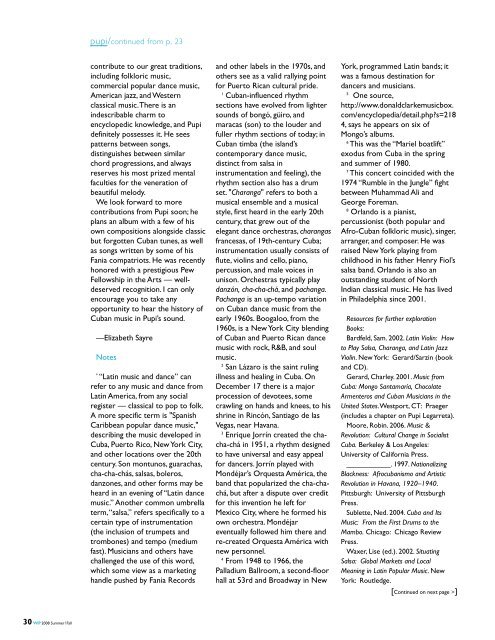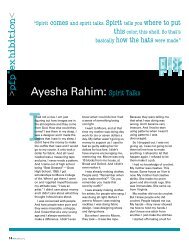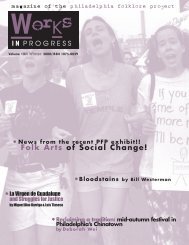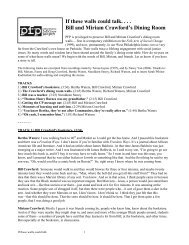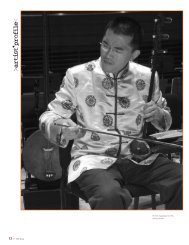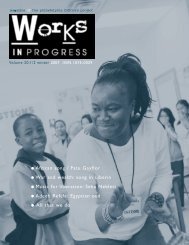View PDF - Philadelphia Folklore Project
View PDF - Philadelphia Folklore Project
View PDF - Philadelphia Folklore Project
Create successful ePaper yourself
Turn your PDF publications into a flip-book with our unique Google optimized e-Paper software.
pupi/continued from p. 23<br />
contribute to our great traditions,<br />
including folkloric music,<br />
commercial popular dance music,<br />
American jazz, and Western<br />
classical music. There is an<br />
indescribable charm to<br />
encyclopedic knowledge, and Pupi<br />
definitely possesses it. He sees<br />
patterns between songs,<br />
distinguishes between similar<br />
chord progressions, and always<br />
reserves his most prized mental<br />
faculties for the veneration of<br />
beautiful melody.<br />
We look forward to more<br />
contributions from Pupi soon; he<br />
plans an album with a few of his<br />
own compositions alongside classic<br />
but forgotten Cuban tunes, as well<br />
as songs written by some of his<br />
Fania compatriots. He was recently<br />
honored with a prestigious Pew<br />
Fellowship in the Arts — welldeserved<br />
recognition. I can only<br />
encourage you to take any<br />
opportunity to hear the history of<br />
Cuban music in Pupi’s sound.<br />
—Elizabeth Sayre<br />
Notes<br />
*<br />
“Latin music and dance” can<br />
refer to any music and dance from<br />
Latin America, from any social<br />
register — classical to pop to folk.<br />
A more specific term is "Spanish<br />
Caribbean popular dance music,"<br />
describing the music developed in<br />
Cuba, Puerto Rico, New York City,<br />
and other locations over the 20th<br />
century. Son montunos, guarachas,<br />
cha-cha-chás, salsas, boleros,<br />
danzones, and other forms may be<br />
heard in an evening of “Latin dance<br />
music.” Another common umbrella<br />
term, “salsa,” refers specifically to a<br />
certain type of instrumentation<br />
(the inclusion of trumpets and<br />
trombones) and tempo (medium<br />
fast). Musicians and others have<br />
challenged the use of this word,<br />
which some view as a marketing<br />
handle pushed by Fania Records<br />
and other labels in the 1970s, and<br />
others see as a valid rallying point<br />
for Puerto Rican cultural pride.<br />
1<br />
Cuban-influenced rhythm<br />
sections have evolved from lighter<br />
sounds of bongó, güiro, and<br />
maracas (son) to the louder and<br />
fuller rhythm sections of today; in<br />
Cuban timba (the island’s<br />
contemporary dance music,<br />
distinct from salsa in<br />
instrumentation and feeling), the<br />
rhythm section also has a drum<br />
set. "Charanga" refers to both a<br />
musical ensemble and a musical<br />
style, first heard in the early 20th<br />
century, that grew out of the<br />
elegant dance orchestras, charangas<br />
francesas, of 19th-century Cuba;<br />
instrumentation usually consists of<br />
flute, violins and cello, piano,<br />
percussion, and male voices in<br />
unison. Orchestras typically play<br />
danzón, cha-cha-chá, and pachanga.<br />
Pachanga is an up-tempo variation<br />
on Cuban dance music from the<br />
early 1960s. Boogaloo, from the<br />
1960s, is a New York City blending<br />
of Cuban and Puerto Rican dance<br />
music with rock, R&B, and soul<br />
music.<br />
2<br />
San Lázaro is the saint ruling<br />
illness and healing in Cuba. On<br />
December 17 there is a major<br />
procession of devotees, some<br />
crawling on hands and knees, to his<br />
shrine in Rincón, Santiago de las<br />
Vegas, near Havana.<br />
3<br />
Enrique Jorrín created the chacha-chá<br />
in 1951, a rhythm designed<br />
to have universal and easy appeal<br />
for dancers. Jorrín played with<br />
Mondéjar’s Orquesta América, the<br />
band that popularized the cha-chachá,<br />
but after a dispute over credit<br />
for this invention he left for<br />
Mexico City, where he formed his<br />
own orchestra. Mondéjar<br />
eventually followed him there and<br />
re-created Orquesta América with<br />
new personnel.<br />
4<br />
From 1948 to 1966, the<br />
Palladium Ballroom, a second-floor<br />
hall at 53rd and Broadway in New<br />
York, programmed Latin bands; it<br />
was a famous destination for<br />
dancers and musicians.<br />
5<br />
One source,<br />
http://www.donaldclarkemusicbox.<br />
com/encyclopedia/detail.phps=218<br />
4, says he appears on six of<br />
Mongo’s albums.<br />
6<br />
This was the “Mariel boatlift”<br />
exodus from Cuba in the spring<br />
and summer of 1980.<br />
7<br />
This concert coincided with the<br />
1974 “Rumble in the Jungle” fight<br />
between Muhammad Ali and<br />
George Foreman.<br />
8<br />
Orlando is a pianist,<br />
percussionist (both popular and<br />
Afro-Cuban folkloric music), singer,<br />
arranger, and composer. He was<br />
raised New York playing from<br />
childhood in his father Henry Fiol’s<br />
salsa band. Orlando is also an<br />
outstanding student of North<br />
Indian classical music. He has lived<br />
in <strong>Philadelphia</strong> since 2001.<br />
Resources for further exploration<br />
Books:<br />
Bardfeld, Sam. 2002. Latin Violin: How<br />
to Play Salsa, Charanga, and Latin Jazz<br />
Violin. New York: Gerard/Sarzin (book<br />
and CD).<br />
Gerard, Charley. 2001. Music from<br />
Cuba: Mongo Santamaría, Chocolate<br />
Armenteros and Cuban Musicians in the<br />
United States. Westport, CT: Praeger<br />
(includes a chapter on Pupi Legarreta).<br />
Moore, Robin. 2006. Music &<br />
Revolution: Cultural Change in Socialist<br />
Cuba. Berkeley & Los Angeles:<br />
University of California Press.<br />
___________. 1997. Nationalizing<br />
Blackness: Afrocubanismo and Artistic<br />
Revolution in Havana, 1920–1940.<br />
Pittsburgh: University of Pittsburgh<br />
Press.<br />
Sublette, Ned. 2004. Cuba and Its<br />
Music: From the First Drums to the<br />
Mambo. Chicago: Chicago Review<br />
Press.<br />
Waxer, Lise (ed.). 2002. Situating<br />
Salsa: Global Markets and Local<br />
Meaning in Latin Popular Music. New<br />
York: Routledge.<br />
[Continued on next page >]<br />
30 WIP 2008 Summer / Fall


